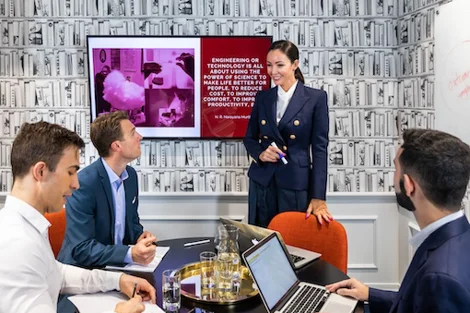
Initiatives to Increase Employee Retention
SHARE

It’s been called the ‘Great Resignation’...
It’s an unprecedented period in the history of professional work in which employees are resigning left, right, and centre. Not necessarily because they are fed up with their jobs, but because greener pastures are always in sight.
There are many reasons for this big shift. For one, a general cultural trend has emerged over the last half-century. Largely gone are the days of a lifelong allegiance to a single company. In a modern economy, like Australia’s, skills are transferable and there is always scope to seek new challenges and new excitement in a new setting. Consequently, the newer generations are more willing and more comfortable moving between jobs.
But most importantly, right now, the world is suffering under the weight of a massive skills shortage, and employers face stiff competition when it comes to luring the talent they need. Higher salaries and more perks are always beckoning.
To put things in perspective, the Australian Bureau of Statistics reported in February this year that 7.5% of employed Australians moved jobs in the previous 12 months, which is just shy of a million people (975,000). Most importantly, the ABS records that professionals are always the most likely group to change jobs, making up 21% of job movements during the 12 months.
Interestingly, the figure of 7.5% was actually the lowest-ever job mobility rate recorded by the ABS. But of course, the reason that the job mobility rate has been so low is that the global pandemic has brought about great uncertainty in the economy and, as well, the logistics of switching jobs in lockdown are intimidating.
Now, though, the pandemic is thought to be easing, life is returning to normal, and Australians are heading back to the office in large numbers. Making matters worse for employers, after a hard slog during lockdown, many employees are likely feeling burned out in their current roles.
The upshot of all of this? Record figures of job mobility are on the horizon.
In sum, this is a time when employers can’t afford to get complacent when it comes to keeping their A-team together. They have to work hard to keep their employees interested, motivated, and happy in their work. And this is where employee retention initiatives come into play.
In this article, we have a look at some of these strategies, as well as the psychology that underlines them.
How To Increase Employee Retention
Before we go theorising employee retention strategies, we need to understand exactly why employees feel the need to leave their jobs. Always trying to see the glass half-full, we could also reframe this question by asking what it is that makes employees stick around.
Knowing when and why employees are thinking about leaving can be hard.
Two years ago, IBM actually went as far as to develop an AI program that allowed it to predict with 95% accuracy whether or not an employee was likely to quit their position. They developed this technology precisely so that they could get to at-risk employees before they committed to jumping ship, being then able to tailor plans and perks to keep them on board. Unfortunately, the technology is under patent and IBM refuses to reveal what information it gathers in drawing its predictive conclusions.
In Australia, we are on the cusp of a period of record job turnover. A recent PWC survey of 1800 Australian workers found that a massive 38% want to move jobs within the next 12 months. The pandemic has slowed job turnover, but when normality returns, we’re likely to see an exodus.
But why is this the case?
PWC’s research allowed the consultancy firm to create a weighted index of the reasons that are motivating workers to stay or nudging them to go. Upfront, 25% of the decision was found to be based on straight-up remuneration— show me the money.
Not surprising.
But after that, a sizable 22% of the decision comes down to wellbeing factors, including mental health support and wellness benefits like gym memberships. A further 16% comes from what the firm calls the experience of their job, encompassing things like workplace culture, inclusion, team spirit, and relationship networks.
Arguably, there isn’t a great deal of difference between the factors that contribute to wellbeing and the factors that contribute to the workplace experience. Both are about making workers feel happy and well in their jobs. With that in mind, the biggest factor determining whether talent stays or goes comes down to how workers are feeling, not just how much dosh is going into their bank account.
Of course, it’s easy to quantify the need for culture and wellbeing, but it’s much harder to quantify what’s needed to actually achieve them. One drink out doesn’t translate into one point towards workplace culture.
Consequently, we have to take a holistic approach to employee retention, implementing multiple initiatives at multiple levels of the workplace. Here are some ideas.
Mentoring & Networking Programs
We know that good leadership is critical to keeping teams together. It’s often said that people don’t leave jobs, they leave managers. And that is often the case in one way or another because an organisation’s leaders are ultimately responsible for setting its culture.
Now, some managers can foster good relationships with their team without even thinking about it. But even good managers can let some employees fall through the cracks, not picking up on their concerns—whether these concerns are directly related to work or not.
Having a mentor program and networking opportunities is one way of giving employees an avenue to speak to an organisational leader, getting support, guidance, and the opportunity to talk through any concerns. Often, an employee’s direct supervisor can act as a mentor. But it can often be useful to assign an employee a mentor that doesn’t work with them day-to-day.
It doesn’t need to be an overly formal relationship either. Maybe a coffee once a fortnight for the first few months, and then once in a while thereafter. Then, once an employee has gone on for a year or two, they can even become a mentor themselves, creating a strong network of bonds across the organisation.
Not everyone needs a mentor, but having the structure in place can just create a stronger sense of organisational belonging. And what’s the harm in having a coffee once a fortnight with a colleague?
Flexible Work Arrangements
Part of making workers feel good about their work situation is giving them the flexibility to strike the right work-life balance. Offering flexibility in terms of where and when employees work gives them the opportunity to do things like spend time with family, socialise, and exercise—all critical factors for promoting general well-being.
Plus, offering tailored work arrangements shows an employee that their organisation or immediate leadership team actually cares about them as an individual.
In terms of employee turnover, the results are startling. A 2017 Deloitte survey found that, within flexible workplaces, 35% of employees imagined moving jobs within two years, versus 33% thinking they would stay beyond five years. On the flipside, non-flexible workplaces produced figures of 45% and 27% for those categories.
The numbers speak for themselves. Flexible work arrangements motivate people to stay engaged with the organisation they work for.
Social Events
It’s a time-worn statement that humans are social creatures. But walking into many workplaces you might sometimes forget it.
Humans crave—in fact they need—regular social interaction. It’s now beyond discussion that socialising radically improves not only mental health but also physical health. But it’s also massively important in motivating people to work hard and stay committed to their organisation.
In the workplace, having meaningful social interaction helps build a sense of community and belonging, which we also know are critical factors in determining employee retention rates.
So, a really simple way to help foster strong social bonds at work is to organise regular social occasions. This doesn’t necessarily mean signing the team up for a weekend soccer tournament or having weekly Friday night drinks on the town.
We can achieve good community development by incorporating socialisation into the workday. Think, for example, of business brunches each Monday to ease back into the working week, birthday celebrations for each team member, or simply Friday lunches.
Even a twenty-minute catch-up coffee on hump-day can help to foster a sense that work is about more than just work.
You never know—you could be one social-interaction-free week away from an employee starting to feel a bit tired and lonely. And once those feelings begin, they have a habit of developing.
Employee Training
Training might not seem like the most attractive workplace perk to keep employees around, but it can be a big pull for those movers and shakers who are thinking about moving on to develop their careers.
Particularly through those first couple of decades of a career, professionals are always looking for ways to give themselves a competitive edge. This can be hard to achieve if they hit a bottleneck of promotions or if they’re stuck doing the same type of work for more than a couple of years.
Paying for recognised qualifications like a CPA certificate can turn out to be a very small investment for keeping a good worker in your team for a few years more.
But training doesn’t need to just lead to formal certifications. Most employees recognise that receiving structured training around key skills and knowledge bases is something that will look very good on their CV in a few years.
Of course, a major benefit of investing in employee training is that you also get the advantage of having more qualified personnel on your team. But even if the training you offer doesn’t contribute directly to a team member’s performance, it’s another incentive for them to stay.
Bring Your Dog to Work Day
Bring Your Dog to Work Day might seem like a bit of a trivial concept when it comes to reducing employee turnover. But in fact, there is lots of evidence supporting this initiative.
It’s been shown that even just spending a bit of time petting a dog can have immediate and lasting benefits in reducing the stress hormone cortisol, as well as boosting the so-called ‘feel-good’ hormone called oxytocin.
Another positive for this initiative is that it also represents an opportunity for more socialisation between employees themselves. Just like organising an office Christmas party or Friday lunches, this is an opportunity for the team to come together and interact with one another on a purely social level. Of course, having the dogs there just raises spirits, helping to build more positive and personal bonds.
Once again, the result is a workplace that puts well-being front and centre, motivating people to be engaged with their work and to stay at the company.
Employee Retention: Think Offense, Not Defense
We’ve had a look at some of the key workplace initiatives aimed at boosting employee retention. But there’s no single answer (except, perhaps, for million-dollar pay rises across the board).
We’ve got to be more holistic in our approach. In other words, we’ve got to think about creating a positive and engaging work environment that people love being a part of.
This is, of course, no easy thing to pull off and, particularly in the modern world, people are still going to switch organisations fairly regularly no matter what we do.
But the great thing about implementing employee retention initiatives is that they’re not just about employee retention. What we now know with real certainty is that some of the biggest factors that make people leave an organisation are also the ones that determine their productivity when they’re there.
We know that employees who have positive work relationships, who feel happy and confident in the office, and who find their work engaging are more likely to produce better work.
In summation, the motivational initiatives we’ve talked about in this blog should not be thought of as defensive strategies designed to guard against good talent leaving. They should be thought of more broadly as offensive strategies aimed at better business outcomes across the board.
Related articles


How To Be A Good Manager


